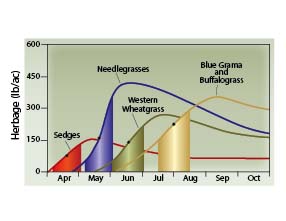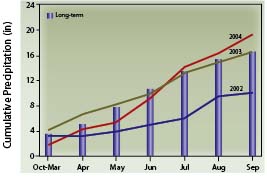When you get caught in these droughts, it’s always… you’ve got to de-stock. The timeline is such a problematic thing. It’s trying to figure out when to do it, when to pull the trigger. When you’re fencing in March or April and there’s no groundwater, do you start de-stocking then or you don’t take as many in? To me, that’s the toughest part about drought is trying to plan when you pull the trigger. When do you de-stock? When do you keep going?
The best time to make decisions, according to livestock producers and advisors across the Great Plains, is sooner rather than later. Here are some reasons why:
1. Plant Year Precipitation
 Rapid growth windows (shaded) for codominant species on Limy Upland sites. Image: Pat Reece.
Rapid growth windows (shaded) for codominant species on Limy Upland sites. Image: Pat Reece.
Precipitation received between last year’s killing frost and this year’s spring green-up results in greater yield of forage per inch of moisture, than does mid-to-late-summer precipitation. If little to no precipitation falls during the dormant season, timely destocking is necessary to avoid damaging rangeland vegetation. So if you’re entering green-up and have seen no precipitation since before last year’s killing frost, or if you are lacking soil moisture, it is already a good time to make changes to this year’s stocking rate.
2. Critical Rain Months
Forage research shows that the most important months for precipitation are the months just prior to the rapid growth periods of your dominant plant species. For much of the Great Plains, those critical rain months occur in spring through early summer. Rainfall that occurs after the rapid growth period of dominant plant species does not result in as much useable forage.
3. Delays in response to precipitation
Areas mapped on the United States Drought Monitor as being in extreme or exceptional drought during the growing season are likely to have a one- to two-week delayed response to rainfall. Additionally, the process of "wetting-up" very dry soils in these areas reduces the availability of rainwater to plants. Delays in plant response to precipitation should be expected when current plant-year precipitation in your immediate area is 75 percent or less of long-term average. Excessive grazing pressure during drought will further reduce or preclude yield responses to even measurable amounts of precipitation.
Nebraska Example - Stocking Decisions During 2002-2004 Drought
 Image: Pat Reece
Image: Pat Reece
For example, based on the precipitation information shown at right, destocking on limy upland ecological sites in the southern Nebraska Panhandle should have been 50 percent by mid-May and 100 percent by mid- to late-June 2002.
Given the severity of drought in the preceding year, turn-out of cattle onto summer pastures in 2003 should have been delayed by two to four weeks with less than pre-drought summer stocking rates.
Relatively low dormant season precipitation before the 2004 growing season would preclude any increase in stocking rate. Delaying turn-out on summer pastures in 2004 would have been beneficial.
The U.S. Seasonal Drought Outlook should be used to implement progressive phases of drought management plans especially drought-induced sale of livestock.